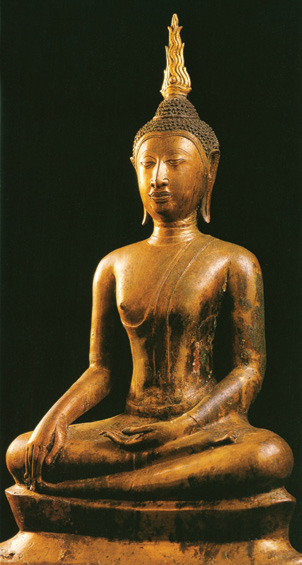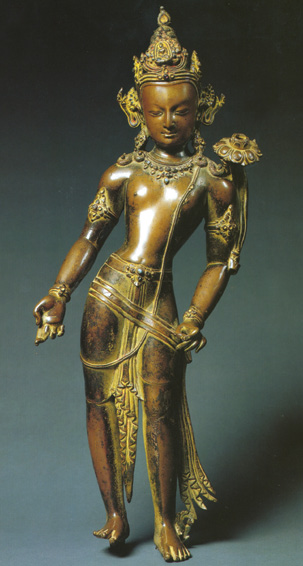An Illustrated Outline of Buddhism: The Essentials of Buddhist Spirituality (19 page)
Read An Illustrated Outline of Buddhism: The Essentials of Buddhist Spirituality Online
Authors: William Stoddart,Joseph A. Fitzgerald
Tags: #Philosophy

of the Sun Dance and the Sacred Pipe.
Within
Mahāyāna
Buddhism there are two distinct perspectives,
one “sapiential” and the other “devotional”. These have crystallized re-
spectively into
Dhyāna
,
Ch’an
,
or Zen Buddhism on the one hand, and
2 With but few exceptions, the original Buddhist terms cited in this book are given
in their Sanskrit form. Pali versions of some of these terms are as follows:
Nibbana
(for
Nirvāna
),
Dhamma
(for
Dharma
),
Attā
(for
Ātmā
),
Sutta
(for
Sūtra
),
Siddhatta
(for
Siddhārtha
),
Gotama
(for
Gautama
),
Metteyya
(for
Maitreya
),
Theravāda
(for
Sthaviravāda
).


The Two Schools and the Two Cultural Forms
55
Sukhāvatī
,
Ching-t’u-tsung
,
or
Jōdo
(“Pure Land”) Buddhism (sometimes known as Amida Buddhism) on the other. (In each case the
names are given successively in Sanskrit, Chinese, and Japanese.) As
religious forms, these branches represent two extreme positions, but
each, nevertheless, is orthodox, in that it is a possible and legitimate
development of the original Buddhist revelation.
The distinction “sapiential”/“devotional”, although valid, is not
absolute. Thus
Jōdo
(or “Pure Land”), though providential y the rep-
resentative of devotion (
bhakti
in Hindu terminology), possesses in
its scriptures the fundamental elements of sapiential metaphysics.
Likewise, the more overtly intellectual Zen sects have also, throughout
their long history, included intensely devotional currents.
In Zen, the point of view is that of “own-power” (Japanese:
jiriki
),
whereas in
Jōdo
, the point of view is that of “power of the Other” (Japa-
nese:
tariki
). One can explain this difference in Western terms by say-
ing that Zen is based on the view that man was created in the image of
God, and relates to the concept of “God Immanent”, whereas,
Jōdo
is
based on the view that man is but a fallen creature in need of mercy,
and relates to the concept of “God Transcendent”. It is as if, in Chris-
tianity, two distinct monastic or spiritual traditions had arisen, one
based on the text “The Kingdom of God is within you” (Luke
17:21),
and the other on the text “Whosoever shall call upon the Name of the
Lord shall be saved” (Romans 10:13). For fuller details on the Pure
Land school, see pp. 79-80
.
The “sapiential” perspective within
Mahāyāna
Buddhism is also
manifested in
Vajrayāna
(the “Diamond Vehicle”), which, in view of
its importance, is called the “Third School” or the third “Setting in Mo-
tion of the Wheel of the Law”.
Vajrayāna
is
the Buddhist form of
tan-
tra
,
a religious perspective and practice well-known in Shivaite Hindu-
ism, and based on the masculine and feminine principles
purusha
and
prakriti
.
The Buddhist form of
tantra
is
sometimes referred to as the
“marriage” of
upāya
and
prajñā
.
It should be noted that, in this pair of celestial principles, it is
upāya
(“formal doctrine and method”) which
is masculine and
prajñā
(“formless wisdom”) which is feminine. For
fuller details on the Buddhist form of
tantra
see pp. 93-97
.
Yet another school which would fall into the “sapiential” category
is
Avatamsaka
or
Hua-yen
(“Flower Garland”), one of the most im-
portant schools in China, and occurring in Japan as
Kegon
.
For fuller
details on the Chinese and Japanese schools, see pp. 101-102 and 116-
117.


56
An Illustrated Outline of Buddhism
U Thong bronze Buddha, Thailand, 14th-15th century
Neither the slothful, nor the fool, nor the undiscerning can
reach
Nirvana.
Iti-vuttaka



The Two Schools and the Two Cultural Forms
57
Bodhisattva Avalokiteshvara, Nepal, c. 12th century
It is a terrible fact that devils always get in the way of those who
are striving for Buddhahood.
Hōnen

58
An Illustrated Outline of Buddhism
The Two Schools or the Two Cultural Forms
Early Buddhism
Hīnayāna/Theravāda
Buddhism
Mahāyāna
Buddhism
(First School)
(Second School)
Ceylon, Burma, Siam,
Tibet, Mongolia, China,
Cambodia, Laos
Vietnam, Korea, Japan
“Sapiential”
“Devotional”
Vajrayāna (Tantrayāna)
(Third School)
Mi-tsung [China];
Shingon [Japan]
Sukhāvatī, Ching-t’u,
or Jōdo (“Pure Land”)
[Amida Buddhism]
Dhyāna, Ch’an,
or Zen Buddhism
Avatamsaka, Hua-yen, or
Tien T’ai or Tendai
Kegon (“Flower Garland”)
(“Heavenly Terrace”)

